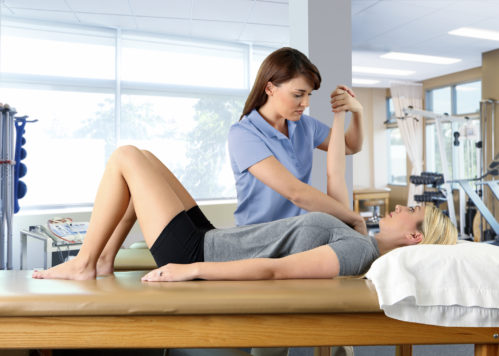
One of the most common injuries seen in a Physical Therapist’s office are torn rotator cuffs. But not many people know what exactly a rotator cuff is, how they injured it or what to expect when recovering from the injury. So let us explain!
The Basic Anatomy
A “rotator cuff” is actually a group of four different muscles working together as the shoulder joint. It can be caused by repeated overuse of the shoulder and can cause extreme damage to the shoulder. Athletes and heavy laborers are commonly affected by injury as are the elderly when they fall or strain the shoulder. Small activities can often injury the shoulder in the elderly such as walking their dogs. If the injury if left untreated, it can cause severe pain and a decrease in the use of the shoulder and arm.
Torn Rotator Cuff
This occurs when the muscles or tendons are injured and cause damage or disruption to the tissue. This injury is either “full-thickness” or “partial-thickness” depending on the severity of the injury. A full-thickness tear extends from the top to the bottom of the cuff. A partial-thickness tear affects some portion of the cuff but not all the way through. Tears often develop from a traumatic event or long-term overuse and are categorized by either acute or chronic. An acute rotator cuff tear is one from a recent injury like a fall or heavy lifting. While a chronic rotator cuff tear is from repeated actions with the arms working above shoulder level.
Diagnosis
The effects of a torn rotator cuff is pain over the top of the shoulder or down the outside arm, weakness, and loss of motion. After pinpointing the cause of injury, a physical therapist will perform specialized tests to diagnose a tear or impingement.
Options for Treatment
If you have an acute injury, seek attention from a physical therapist or other health care provider to rule out other injuries that may be life threatening. Your healthcare provider or therapist will help you manage your pain and prepare you for the course of treatment that best fits your.
For chronic injury, a physical therapist will help you manage the symptoms and will help you improve your range of motion. For larger tears, a physical therapist might send you to an orthopedic surgeon or teach you special strategies to improve the movement.
If surgery is needed to repair the damage of a full-thickness tear, a physical therapist will help you recover once the surgery is complete. Because the cuff will be vulnerable, it is important not to injure the shoulder again. A physical therapist will help you heal with building exercises which will increase with time.
Contact Us to Learn More About Physical Therapy
If you’d like to schedule an appointment to help with your aches and pains, call Life Fitness Physical Therapy today at 410-368-1026, or find the nearest location. If you’d like more information about what to expect on your first visit with us, please check out the FAQ section of our website.
